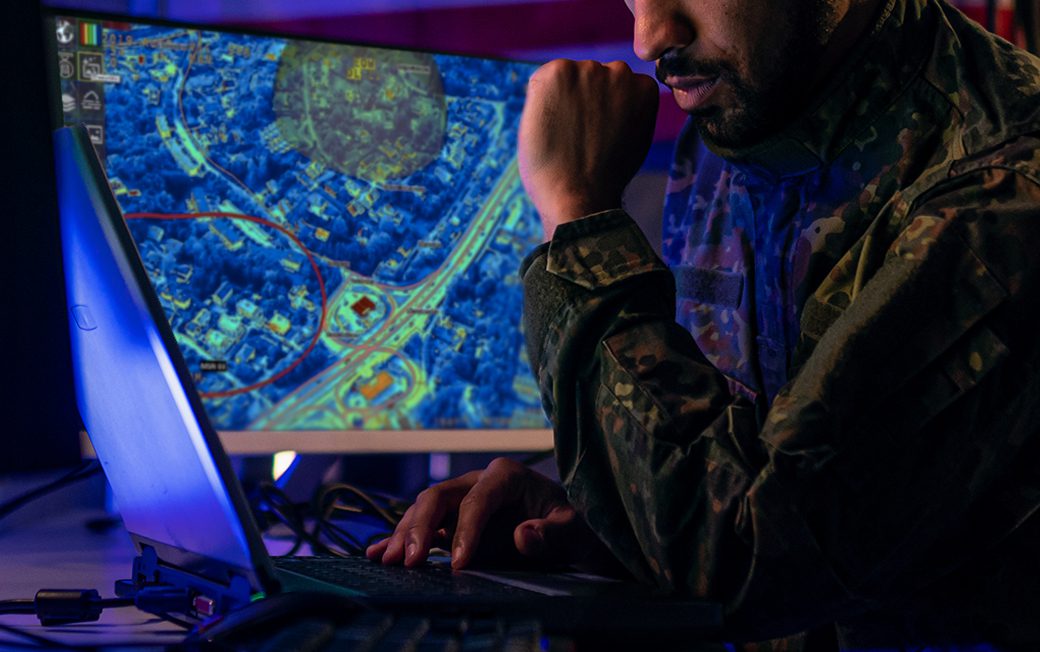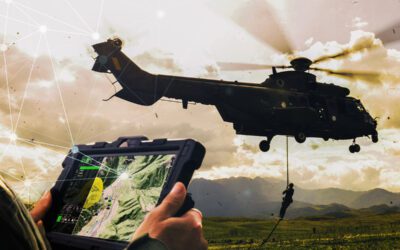Artificial Intelligence (AI) has become a transformative force across various sectors. And the military domain is no exception. With its ability to process enormous amounts of data, analyse complex patterns and make instant decisions, AI has revolutionised military technology.
However, the defence sector deploys AI in so many different ways that it is often difficult to understand just how revolutionary it is. Whether it is facilitating the development of autonomous vehicles or playing a critical cybersecurity role, AI underpins many of the significant defence sector developments of recent years.
With this in mind, we will explore eight of the most powerful artificial intelligence applications in military technology and discuss what they mean for the sector as a whole.
1. Autonomous weapon and vehicle systems
One of the most notable ways militaries are utilising AI is the development of autonomous weapons and vehicle systems. AI-powered crewless aerial vehicles (UAVs), ground vehicles and submarines are employed for reconnaissance, surveillance and combat operations and will take on a growing role in the future.
While still far from widespread implementation, adopting autonomous systems could radically alter how we conceive of military conflict, further distancing human participants from the battlefield. It is a fundamental concern for many leading militaries, which are investing significantly in ensuring that autonomous capabilities are up-to-date and developing at the necessary rate.
2. Intelligent command and control systems
AI is transforming command and control systems by enabling real-time data analysis, decision-making and situational awareness. AI-driven systems have access to far more data and perform analysis much more efficiently and quickly than human actors, enabling them to consider more factors when making an analysis.
That said, the immediate future will see AI systems augment human intelligence by streamlining simple processing tasks and providing decision-makers with the data and guidance they require to make informed decisions. As such, the technology will contribute to optimising mission planning, resource allocation and tactical operations.
3. Performing predictive maintenance
So much of military success depends on behind-the-lines management and planning. For instance, ensuring military equipment is in peak condition is crucial for mission success. Without well-maintained equipment, strategic and technological advantages cannot be realised, and systems begin to break down.
The defence sector can utilise AI algorithms to analyse data acquired from battlefield sensors and other sources to predict equipment failures before they occur. By analysing available data and recognising patterns and anomalies, predictive maintenance systems can optimise maintenance schedules, reduce overall downtime and enhance the reliability of military assets. In turn, this ensures units can operate at maximum capacity and fulfil their strategic and operational role.
4. Logistics and maintenance
We can also apply the logic behind predictive maintenance to broader logistics and maintenance systems. Modern warfare depends on increasingly complex and interdependent logistics networks that require careful management. While militaries honed these networks over the years, they are still prone to human error and are far from optimised.
Militaries can and do leverage AI-powered technologies to help reduce overall costs, minimise the need for human input and optimise distribution and transport. As the Internet of Things (IoT) expands and the number of data inputs available increases, AI’s ability to successfully automate large portions of the logistics process will improve exponentially. This will make for more efficient and responsive logistics systems that adapt to changing circumstances to deliver the best possible outcomes.
5. Tightening cybersecurity
The defence sector is increasingly reliant on interconnected digital systems and networks. While this enables it to achieve remarkable things and develop and deploy increasingly capable technologies, it is also a potential weakness. Should an enemy actor compromise the security of those systems, the ramifications could be severe.
Fortunately, AI plays a vital role in detecting and mitigating cyber threats. Machine learning algorithms are put to work analysing network traffic, identifying potential vulnerabilities and responding to cyber attacks in real time. This helps secure networks against attack. Such systems also learn from previous incidents and constantly evolve, creating an agile and responsive cybersecurity infrastructure.
6. Intelligence and surveillance
AI is revolutionising intelligence gathering and surveillance operations. Advanced computer vision techniques enable the analysis of vast amounts of imagery and video data, aiding in target identification, tracking, and object recognition. AI algorithms can sift through enormous amounts of data from various sources, including social media, to extract relevant information and enhance situational awareness.
This is taking intelligence capabilities to an entirely new level. Over the last few decades, we have begun to recognise and better understand the sheer amount of data modern digital systems generate. However, as we had not developed our analysis mechanisms sufficiently, we had few ways of leveraging that data. That has changed with the adoption and implementation of advanced AI technologies. We can now analyse that data and generate valuable insights to inform threat detection and intelligence systems.
7. Decision support systems
In high-pressure situations, actors throughout the military hierarchy require accurate and timely information to make the best possible decision. However, human decision-making processes are imperfect and often result in suboptimal outcomes. One of the key obstacles is the availability of information. Human actors cannot factor in all relevant factors. AI support systems can.
By processing diverse data streams, including real-time intelligence, weather data, logistical information, automatic target recognition and an endless array of other sources, AI applications can evaluate multiple scenarios, assess risks and recommend optimal courses of action. Again, this type of application is not designed to replace human decision-making but augment and improve it.
8. Simulations and training
AI-driven simulations and virtual environments are essential for training military personnel in realistic scenarios. Intelligent virtual opponents can adapt their behaviour, learn from interactions and provide realistic training experiences. Not only that, but they can tailor their responses and training stimuli to specific individuals. It allows for bespoke training regimes that work to develop personal weaknesses.
AI-powered training systems help to develop critical skills, decision-making abilities, and situational awareness, preparing military personnel for complex and dynamic operational environments. This extends beyond frontline combat to broader battlefield strategy. It also achieves this without putting personnel in danger. Finally, AI-powered training simulations will prove far more cost-effective than their real-life equivalents over the long run.
FlySight AI applications
The applications of artificial intelligence in military technology are diverse and constantly evolving. We have yet to fully understand the technology’s full potential, and the defence sector is continuously developing new applications and functions. From optimising logistics and transportation planning to providing realistic AR training to combatants, AI is the foundational technology on which we will develop the next generation of defence sector innovations.
At FlySight, we design and develop geospatial software solutions for mission-critical scenarios. Our multi-platform Processing, Exploitation and Dissemination (PED) system, OPENSIGHT®, provides real-time support to decision-makers by providing them with a geo-exploitation toolbox that facilitates intelligent mission data analysis and visualisation. Driven by advanced AI technology, it is changing how the defence sector thinks about AI and enabling more informed decision-making.
To learn how FlySight is spearheading innovation in the defence sector, head to our OPENSIGHT product page or contact the FlySight team via our online contact page.




